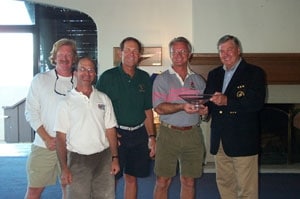
John Burnham trimmed headsails for Dave Irish on a J/105 at the International Masters Regatta on San Francisco Bay recently. If you missed the first, second, or third installment of what he learned in the process click here.
With one race to sail on Sunday we were 5 points behind John Jennings and 3 behind Keith Musto. Lurking 2 behind us was Bruce Munro. Regrettably, we were on the flat part of our learning curve for this regatta. Dave was sailing the boat very fast, but tactically Bill and I weren’t putting it together. Dave jumped out to a great start near the leeward end and came up the City Front gaining on the boats to windward because we were sailing in the stronger part of the new ebb tide, which first gets moving there. At one point we could’ve tacked and crossed all but one boat. Too bad we didn’t, because just as we’d done the day before, we sailed out of the best current by the Golden Gate YC and fell from the front to the back in the blink of an eye. (See Mistake No. 1 in last week’s story.) This prompted several reflections on my part.
Reflection No. 1: We challenged after that, but could never fight our way through to the front, which was probably a result of the overall boatspeed improvement in the Masters fleet. Our extra practice may have given us a headstart in our speed and handling on Day One, but by this time most of the boats were even.
Reflection No. 2: We finished the race in seventh, and with Munro winning the race, the consistent Jennings staying out of trouble, and Musto finishing close behind us, we dropped to fourth for the regatta. Where we failed was in developing an ability to execute the best tactics and strategy, which is decisive in any fleet with even speed. As sailors get older and more experienced, with age comes wisdom, but the master’s ultimate dilemma is this: it becomes progressively harder to remember yesterday’s lessons.
Reflection No. 3: Does it matter? Well, it doesn’t feel good to let down your skipper when, with a few smarter calls, you know you could’ve been in the hunt. After all the effort and expense, you hate to do less than your best; but on the other hand, you have to consider the fact that maybe this was our best given who we were as individuals and how we gelled as a crew. With time, you can relax and feel just fine about finishing fourth in any regatta, especially in a regatta such as this considering that there were many outstanding sailors placing behind us.
Reflection No. 4: Does it matter? Of course not. We joined together as a crew to play a game. We did our jobs pretty well, we shared a lot of laughs, the wind was strong, the courses fair. We got to know a fantastic place to sail, and we got to know a fine group of individuals. Most were mellow, the mainsheet trimmer and tactician sitting behind me, for example; some were wired (well, one was wired), that is, the pro ski racer on the bow. I had the pleasure of sitting beside the harpist amidships who pulled all the strings in the pit and would wear her bruises proudly for a week. It was a great education to race on three different J/105s for the week with three different owners–Tom Struttman, Eden Kim, and Jaren Leet. And it was especially a privilege to sail with the man we all began calling, “The Master”–an unassuming Mumm 30 racer and boatyard owner from Harbor Springs, Mich. I’d known Dave Irish from 14 years of US SAILING meetings, three of which he served the sport as president, and I found his easy-going yet lucid manner transferred naturally to a racing boat. In fact, that may be where he developed and refined a style that will draw other racers to sail with him for as long as he keep assembling crews. Hopefully I’ll get to join him again.









